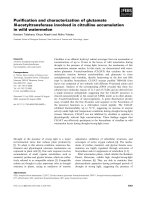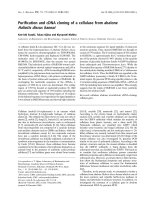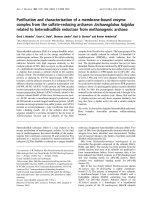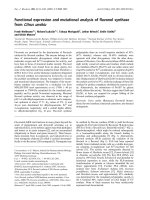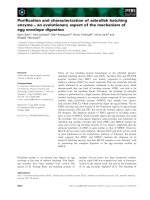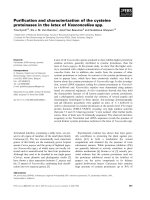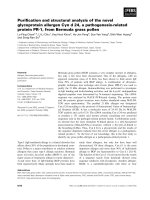Báo cáo khoa học: Purification and kinetic analysis of the two recombinant arogenate dehydrogenase isoforms of Arabidopsis thaliana pptx
Bạn đang xem bản rút gọn của tài liệu. Xem và tải ngay bản đầy đủ của tài liệu tại đây (522.66 KB, 9 trang )
Purification and kinetic analysis of the two recombinant arogenate
dehydrogenase isoforms of
Arabidopsis thaliana
Pascal Rippert and Michel Matringe
Laboratoire Mixte CNRS/INRA/Bayer CropScience (UMR 1932), Lyon, France
The present study reports the first purification and kinetic
characterization of two plant arogenate dehydrogenases
(EC 1.3.1.43), an enzyme that catalyses the oxidative
decarboxylation of arogenate into tyrosine in presence of
NADP. The two Arabidopsis thaliana arogenate dehy-
drogenases TyrAAT1 and TyrAAT2 were overproduced
in Escherichia coli and purified to homogeneity. Bio-
chemical comparison of the two forms revealed that at
low substrate concentration TyrAAT1 is four times more
efficient in catalyzing the arogenate dehydrogenase reac-
tion than TyrAAT2. Moreover, TyrAAT2 presents a
weak prephenate dehydrogenase activity whereas Tyr-
AAT1 does not. The mechanism of the dehydrogenase
reaction catalyzed by these two forms has been investi-
gated using steady-state kinetics. For both enzymes,
steady-state velocity patterns are consistent with a rapid
equilibrium, random mechanism in which two dead-end
complexes, E–NADPH–arogenate and E–NADP–tyro-
sine, are formed.
Keywords: Arabidopsis thaliana; tyrosine biosynthesis;
arogenate dehydrogenase; isoforms; enzymatic properties.
Archae, eubacteria, plants, and fungi are capable of
synthesizing, de novo, the three aromatic amino acids
phenylalanine, tyrosine, and tryptophan. The enzymes
catalyzing these reactions are thus potentially useful targets
for the development of new antibiotics, fungicides and
herbicides. The broad-spectrum herbicide glyphosate that
inhibits 5-enolpyruvyl shikimate 3-phosphate synthase is
the best example of this potential [1].
For the biosynthesis of phenylalanine and tyrosine,
alternative routes exist in nature (Fig. 1). In organisms
such as Saccharomyces cerevisiae or Escherichia coli [2,3],
phenylpyruvate and p-hydroxyphenylpyruvate serve as
the direct precursors of phenylalanine and tyrosine,
respectively. In most plant however, both amino acids
are formed from a common precursor
L
-arogenate [4–7].
Furthermore, a widespread combination of the alternat-
ive routes can be found. For example, in cyanobacteria,
and some other microorganisms, both arogenate-to-
tyrosine and phenylpyruvate-to-phenylalanine pathways
exist [8–12]. In other bacteria, e.g. Pseudomonas aerugi-
nosa and Zymomonas mobilis, the alternative pathways to
phenylalanine and tyrosine coexist [13,14]. Whatever the
synthetic route adopted, a fine tuning at the branch
points is required to balance the flow of intermediates; a
wide variety of control mechanisms have been reported,
including multivalent allosteric feed back control by end
products (reviewed in [15–17]). In most organisms, the
aromatic amino acid biosynthetic pathway also plays a
pivotal role in the production of precursors for a myriad
of aromatic secondary metabolites engaged in a very
diverse range of processes [18]. This opens the possibility
to deregulate the pathway in favor of one of the three
aromatic amino acids, by overexpressing a foreign
enzyme with a completely different pattern of regulation.
However, the existence of many different combinations
for routing prephenate to phenylalanine or tyrosine
means that the substrate specificity of a particular
enzyme, and its susceptibility to feedback regulation by
different metabolites is not predictable, and must be
studied in detail.
In a previous study [19], we reported on the identi-
fication of two structural genes encoding plastidic
Arabidopsis thaliana arogenate dehydrogenase named,
respectively, tyrAAT1 (accession number AF434681),
and tyrAAT2 (accession number AF434682), and the
characterization of the recombinant protein TyrAAT1.
This protein was structurally unusual in that a single
polypeptide chain housed two highly similar domains.
Our study revealed that both peptide domains sustained
arogenate dehydrogenase activity with similar biochemi-
cal characteristics. The second isoform, TyrAAT2,
appeared later in the A. thaliana databases [20] and did
not present these repeated peptide domains. The aim of
the present study was to conduct a biochemical compar-
ison of these two isoforms of arogenate dehydro-
genase and a detailed kinetic analysis of their substrate
specificity and reaction mechanisms to gain further
insight into their respective roles in tyrosine metabolism.
To date, reports of such mechanistic studies have
been limited to a related bifunctional enzyme choris-
mate mutase-prephenate dehydrogenase from bacteria
[3,21,22].
Correspondence to M. Matringe, Laboratoire Mixte CNRS/INRA/
Bayer CropScience (UMR 1932), Bayer CropScience,
14–20 rue Pierre Baizet, 69263 Lyon cedex 9, France.
Fax: + 33 472 85 22 97, Tel.: + 33 472 85 28 47,
E-mail:
Abbreviations: TyrAAT1, Arabidopsis thaliana arogenate
dehydrogenase isoform 1; TyrAAT2, Arabidopsis thaliana
arogenate dehydrogenase isoform 2.
(Received 7 June 2002, revised 2 August 2002,
accepted 6 August 2002)
Eur. J. Biochem. 269, 4753–4761 (2002) Ó FEBS 2002 doi:10.1046/j.1432-1033.2002.03172.x
MATERIALS AND METHODS
Materials
Isopropyl thio-b-
D
-galactoside was purchased from Bio-
probe. Prephenate, NAD, NADP, benzamidine HCl, amino
caproic acid were obtained from Sigma.
Arogenate was synthesized enzymatically from prephen-
ate and aspartate as described by Rippert & Matringe
[19]. Arogenate was further purified from the reaction using
the following steps as described by Jensen et al.[28].
The arogenate solution in 1 m
M
potassium phosphate,
pH 8.0 was passed through a Dowex-chloride column
(1.6 · 30 cm, Sigma) at a flow rate of 2 mLÆmin
)1
.The
column was then washed with 100 mL of 1 m
M
potassium
phosphate, pH 8.0. Arogenate is eluted from the Dowex-
chloride column with a 100 mL of 0.5
M
NH
4
HCO
3
.
Arogenate eluted was then lyophilized, resuspended in
50 m
M
Hepps pH 8.6 and stored frozen at )20 °C.
Bacterial strains
The E. coli AT 2471 [23], tyrA relA spoT thi mutant was
purchased from E. coli Genetic Stock Center. This mutant
was lysogenized with the helper phage (kDE3) harboring a
copy of the T7 RNA polymerase gene, using the kDE3
lysogenization kit from Novagen, according to manufac-
turer’s instructions. The resulting E. coli AT 2471(kDE3)
was used to express cDNAs cloned in the pET vector under
the control of the T7 promoter. Electro-competent cells of
this strain, prepared according to the method of Dower
et al. [24], were transformed with the pET28-TyrAAT1 and
pET21-TyrAAT2 constructs.
Engineering of expression vector
BLAST
search using available prephenate and arogenate
dehydrogenase protein sequences allowed us to identify two
A. thaliana arogenate dehydrogenase genes (accession num-
ber AF434681 and AF434682) [19]. The corresponding full-
length cDNAs were obtained by PCR amplification of an
Arabidopsis (var. Columbia) cDNA library constructed in
pYes. The cloning of tyrAAT1 was previously described [19]
under the name tyrAATc.TheNdeI–BamHI DNA frag-
ments containing the coding sequence without the transit
peptide [19] was cloned into the plasmid pET28 b(+) to
place a 6·His tag at the NH
2
terminus of the polypeptide.
According to the
CHLOROP
prediction [30] the putative
mature protein started at position 36 from the first
methionine [19]. The 5¢-oligonucleotide P1 (5¢-CACTAC
TCACAATGCTACTCCATTTCTCTCCG-3¢ and the
3¢-oligonucleotide P2 (5¢-GCATAATCCAG
GATCCC
TTGTGATCTTAAGATG-3¢) were used for PCR ampli-
fication of the full length tyrAAT2 cDNA. This 3¢-oligonu-
cleotide is complementary to the beginning of the 3¢UTR,
and introduced a BamHI restriction site (underlined). The
full-length PCR fragment was cloned into the plasmid
pPCR-Script (Stratagene). Constructs lacking the transit
peptide sequence were produced according to the
CHLOROP
prediction [30] by replacing the arginine in position 36 by a
methionine. We used P3 (5¢-CTCTTCGAATT
CATATG
ATCGACGCCGCCC-3¢) that introduced an ATG initi-
ator and a NdeI restriction site (underlined) in position 108
from the first in frame ATG codon and P2. Then the
resulting PCR NdeI–BamHI DNA fragment was cloned
into the plasmid pET21 a(+), yielding the plasmid pET21-
TyrAAT2.
For both constructs, sequencing of the entire insert was
carried out and was in complete agreement with the
expected sequences. The theoretical masses of the products
TyrAAT1 and TyrAAT2 were determined to be 68.5 kDa
and 36 kDa, respectively.
Expression and purification of recombinant TyrAAT1
The E. coli AT 2471(kDE3) cells transformed with pET28-
TyrAAT1 were grown at 37 °C in Luria–Bertani medium
supplemented with the appropriate antibiotics. When D
600
reached 0.6, 1 m
M
of isopropyl thio-b-
D
-galactoside was
added to induce recombinant protein synthesis. The cells
were further grown for 16 h at 28 °C, harvested, and
centrifuged for 20 min at 4000 g. The pellet was resus-
pended in buffer A (20 m
M
Tris/HCl, pH 7.9, 500 m
M
NaCl) containing 5 m
M
imidazole and sonicated with a
Vibra-cell disrupter (Sonics and Materials, Danbury, CT,
USA) (100 pulses every 3 s on power setting 5). The crude
extract obtained was centrifuged for 20 min at 18 000 g.
The soluble protein extract was applied to a Ni-nitrilo-
triacetic acid agarose column (1.6 · 3 cm; Qiagen) column
previously equilibrated with 30 mL of buffer A containing
5m
M
imidazole. The column was washed with buffer A
containing 60 m
M
imidazole. The recombinant protein was
eluted using buffer A containing 250 m
M
imidazole. Frac-
tions containing the major arogenate dehydrogenase acti-
vity were pooled and dialyzed against buffer A. Enzyme
was stored at 4 °C without loss of activity during several
months.
Fig. 1. Biosynthesis pathway leading to tyrosine and phenylalanine. The
alternative for the synthesis of tyrosine and phenylalanine from pre-
phenate are represented. EPSP synthase, 5-enolpyruvyl shikimate
3-phosphate synthase.
4754 P. Rippert and M. Matringe (Eur. J. Biochem. 269) Ó FEBS 2002
Expression and purification of recombinant TyrAAT2
The E. coli AT 2471(DE3) strain transformed with pET21-
TyrAAT2 were grown at 37 °C in Luria–Bertani medium
supplemented with the appropriate antibiotics. When D
600
reached 0.6, 1 m
M
of isopropyl thio-b-
D
-galactoside was
added to induce recombinant protein synthesis. The cells
were further grown for 16 h at 28 °C, harvested, and
centrifuged for 20 min at 4000 g. The pellet was resuspended
in buffer B containing 50 m
M
Tris/HCl, pH 7.5, 1 m
M
EDTA, 1 m
M
dithiothreitol, 1 m
M
benzamidine HCl,
5m
M
amino caproic acid, and sonicated with a Vibra-cell
disrupter (Sonics and Materials) (100 pulses every 3 s on
power setting 5). The crude extract obtained was centrifuged
for 20 min at 18 000 g.
The soluble protein extract was subjected to ammo-
nium sulfate fractionation by addition of solid (NH
4
)
2
SO
4
(20% saturation) at 4 °C. After 20 min of stirring, the
mixture was centrifuged at 40 000 g for 20 min and the
supernatant was brought to 40% saturation with solid
(NH
4
)
2
SO
4
at 4 °C. The precipitate was recovered by
centrifugation and resuspended in a minimum volume of
buffer A. The resulting protein extract was applied to a
Hiload Superdex S200 (3.2 · 60 cm, Pharmacia), column
connected to an FPLC system (Pharmacia) previously
equilibrated in 200 mL of buffer B. Fractions enriched
with arogenate dehydrogenase were pooled and the
enzyme was stored at 4 °C without loss of activity during
several month.
Protein concentration
Total protein concentration was determined with the Bio-
Rad protein assay with c-globulin as the standard, as
described by Bradford [25]. The concentration of purified
arogenate dehydrogenase was also determined by measur-
ing the absorbance at 205 nm [26].
Electrophoretic analyses of proteins
For the analysis of the protein purification, polypeptides
were separated by SDS/PAGE containing 12% (w/v)
acrylamide as detailed by Chua [27] and visualized by
staining with Coomassie Brilliant Blue R250.
Enzyme activities
To monitor protein purification, prephenate and arogen-
ate dehydrogenase activities were assayed according to
Bonner & Jensen [29] by following at 25 °Ctheformation
of NADH or NADPH at 340 nm in a buffer containing
50 m
M
Tris/HCl, pH 7.5, 300 l
M
prephenate or arogen-
ate, and 1 m
M
NAD or NADP in a total volume of
200 lL.
Enzyme activity is expressed in UÆmg
)1
,were1Uis
defined as 1 lmol NAD(P)H formed per min.
Data analysis
Kinetic data were analyzed with
KALEIDAGRAPH
program
(Abelbeck Software) providing an iterative fit to the
appropriate equation by using a nonlinear curve-fitting
method.
Hyperbolic curve were fitted to the following equation:
v ¼
V
app
m
:½S
K
app
m
þ½S
ð1Þ
And sigmoidal curve were fitted to the following equation:
v ¼
V
app
m
:½S
n
K
app
m
þ½S
n
ð2Þ
where V
app
m
and K
app
m
are the apparent V
m
and K
m
values for
one substrate at different fixed value for the concentration
of the second substrate and n is the Hill coefficient.
RESULTS
Two forms of arogenate dehydrogenase were previously
identified in the A. thaliana databanks, tyrAAT1 (accession
number AF434681), and tyrAAT2 (accession number
AF434682) [19]. tyrAAT1 was previously described under
the name tyrAATc [19]. According to the
CHLOROP
predic-
tion program [30], the two forms present a putative plastidic
transit peptide sequence. This finding is in good agreement
with a plastidic localization of all other enzyme activities
involved in aromatic amino acids biosynthesis (reviewed in
[16,17]). We have reported previously that TyrAAT1 is
comprised of two highly similar peptide domains Tyr-
AAT1.1 and TyrAAT1.2 (Fig. 2A). A biochemical analy-
sis carried out on crude protein extracts revealed that
both domains possess arogenate dehydrogenase activity
[19]. The second isoform, TyrAAT2, does not contain
repeated domains (Fig. 2A). Sequence comparison
between TyrAAT2 and each of the two peptide domains of
TyrAAT1 revealed more than 50% identity in the two cases
(Fig. 2B).
Purification of TyrAAT1 and TyrAAT2
The two recombinant isoforms of A. thaliana arogenate
dehydrogenase TyrAAT1 and TyrAAT2 lacking their
putative plastidic transit peptide were overproduced in the
E. coli mutant strain AT 2471(DE3) cells devoid of
endogenous prephenate dehydrogenase activity [23]. Both
isoforms were purified to near homogeneity (more than
95% of purity) as assessed by denaturing PAGE and
visualization by Coomassie Blue staining. As documented in
Fig. 3, in denaturing condition both purified proteins have
the expected molecular mass deduced from their coding
sequences, i.e. 66 vs. 68 kDa and 38 vs. 37 kDa for
TyrAAT1 and TyrAAT2, respectively. Recombinant
TyrAAT1 was never recovered in large amounts in the
soluble protein fraction [19], we thus decided to carry out a
purification of a recombinant His-tagged TyrAAT1 in a
one-step procedure via Ni-nitrilotriacetic acid affinity chro-
matography. This purification process resulted in a 700-fold
enhancement of the specific activity (Table 1). About
1.4 mg of enzyme was routinely obtained from 1 g of
soluble proteins. TyrAAT2 was expressed without its transit
peptide as described in Materials and methods. The
resulting protein was successfully overproduced in AT
2471(DE3) cells and was recovered mainly as soluble
protein. Recombinant TyrAAT2 arogenate dehydrogenase
was excluded from a gel filtration S200 column (Fig. 3B).
Therefore, a two step purification strategy was adopted for
Ó FEBS 2002 Arogenate dehydrogenases of A. thaliana (Eur. J. Biochem. 269) 4755
this enzyme and consisted of precipitation in a 20–40%
ammonium sulfate followed by chromatography on a S200
gel filtration column (Fig. 3A, Table 1). This purification
resulted in a 12-fold enhancement in specific activity. About
17 mg of enzyme was routinely obtained from 1 g of soluble
protein by this procedure.
Size exclusion chromatography using Superdex S200
revealed that TyrAAT1 eluted with a mobility consistent
with that of a monomeric protein of 67 kDa (Fig. 3B), and
in total agreement with the mass estimated by denaturing
PAGE(i.e.66kDa,Fig.3A).Incontrast,TyrAAT2eluted
in the void volume of the S200 column even in presence of
300 m
M
NaCl (Fig. 3B). A similar behavior was found with
the TyrAAT2 arogenate activity found in crude protein
extract of cultured cells from A. thaliana. This finding,
Fig. 2. Schematic diagram of the amino acid sequence of the two
A. thaliana arogenate dehydrogenases TyrAAT1 and TyrAAT2 deduced
from their respective coding sequences (A) and alignment of amino acid
sequence of the two protein domains of TyrAAT1 (TyrAAT1.1, and
TyrAAT1.2), and TyrAAT2 using the
CLUSTALW
program (B). (A)
Putative transit peptide cleavage site determined using
CHLOROP
pro-
gram are indicated (i.e. Val36 for TyrAAT1 and Arg 36 for TyrAAT2).
(B) Conserved residues are noted by *, and high similarity residues are
noted by colons.
Fig. 3. Purification for the two A. thaliana arogenate dehydrogenases
TyrAAT1 (left) and TyrAAT2 (right) monitored by SDS/PAGE (A)
and behavior of TyrAAT1 and TyrAAT2 by chromatography on
Superdex 16/60 S200 (B). (A) Polypeptides were separated on SDS/
PAGE gels and stained with Coomassie brillant blue R-250. Lane 1:
crude soluble extract (15 lg) of E. coli AT 2471(DE3) cells trans-
formed with pET28-TyrAAT1. Lane 2: Fraction containing
TyrAAT1 eluted from a Ni-nitrilotriacetic acid agarose column by a
250-m
M
imidazole buffer (1 lg). Lane 3: crude soluble extract
(15 lg) of E. coli AT 2471(DE3) cells overproducing TyrAAT2.
Lane 4: ammonium sulfate 20–40% fractionation of crude soluble
extract of E. coli AT 2471(DE3) cells overproducing TyrAAT2
(10 lg). Lane 5: Fraction containing TyrAAT2 eluted from a S200
gel filtration column (2 lg). The minor polypeptide of 72 kDa
resolved in lane 5 correspond to a dimeric form of TyrAAT2. This
was determined by Western blot analysis. MW: molecular mass
markers. (B) A 0.5-mL sample of purified TyrAAT1 or TyrAAT2
(1 mg) were applied to the S200 column and eluted at 1.5 mLÆmin
)1
in a buffer containing 50 m
M
Tris/HCl, pH 7.5. The straight line
represents the profile of activity obtained with TyrAAT1 and
the dashed line the profile of activity obtained with TyrAAT2.
TyrAAT2 eluted in the void volume of the S200. TyrAAT1 eluted
with a Ve/Vo of about 1.7 which correspond to an apparent mass
of 67 kDa as determined by comparison with mobility of standard
protein (insert panel). Standards used (1 mg) were thyroglobulin
(669 kDa), apoferritin (443 kDa), b-amylase (200 kDa), alcohol
dehydrogenase (150 kDa) and bovine serum albumin (66 kDa).
4756 P. Rippert and M. Matringe (Eur. J. Biochem. 269) Ó FEBS 2002
together with the result from SDS/PAGE, indicates that
native and recombinant TyrAAT2 form oligomers with a
molecular mass greater than 600 kDa.
Kinetic analyses
The two enzymes are strictly NADP-dependent. Both forms
obeyed Michaelis–Menten behavior at saturating concen-
trations of the second substrate. The presence of a His-tag at
the NH
2
terminus of TyrAAT1 did not modify its kinetics
properties as its K
m
values for NADP and arogenate were
very similar to the values previously determined with the
unpurified recombinant protein devoid of His-tag [19].
Michaelis–Menten constants for arogenate and NADP are
presented in Table 2. K
m
values for NADP were found to be
10.2 l
M
and 14.3 l
M
for TyrAAT1 and TyrAAT2, respect-
ively. They are in the same order of magnitude as that
previously reported for unpurified plant arogenate dehy-
drogenases [5,6,19,31]. The K
m
values for arogenate were
52.6 and 84.2 l
M
for TyrAAT1 and TyrAAT2, respectively
(Table 2). The K
m
values for arogenate reported in the
literature for other plant enzymes differ significantly. They
range from 67 to 340 l
M
[4–6,19,31].
Values for the maximal velocity (V
m
) obtained for
purified TyrAAT1 and TyrAAT2 were 142 and 73 UÆmg
)1
,
respectively. They are higher than those reported for
prephenate dehydrogenase [3,21], and are of the same order
of magnitude as that reported for the arogenate dehydrog-
enase purified from Phenylobacterium immobile [12], and
from Synechocystis (Rippert & Matringe, in preparation).
The V
m
of TyrAAT1 is twice that of TyrAAT2. If we
consider that the two active sites of TyrAAT1 are
equivalent, values for the turn over number (k
cat
)were
determined as 84 s
)1
for one domain of TyrAAT1 and
37 s
)1
for one TyrAAT2 monomer. Values for the catalytic
efficiency (k
cat
/K
m
) for arogenate were estimated at
1.6 · 10
6
M
)1
Æs
)1
and 0.44 · 10
6
M
)1
Æs
)1
for TyrAAT1
and TyrAAT2, respectively (Table 2). The two isoforms
differ also with respect to their capacity to use prephenate as
an alternative substrate. TyrAAT1 was incapable of cata-
lyzing the transformation of prephenate to p-hydroxyphe-
nylpyruvate regardless of the concentration of prephenate
tested(i.e.upto1m
M
). However, prephenate at high
concentrations could bind to the active site as it behaves as a
competitive inhibitor with respect to arogenate (not shown).
Its apparent K
i
value was estimated at 4.2 m
M
(Table 3). In
contrast, the second isoform TyrAAT2 exhibits weak
prephenate dehydrogenase activity. From our data, its K
m
and k
cat
values could be estimated as 17 m
M
and 3.4 s
)1
,
respectively, and the catalytic efficiency for prephenate
(k
cat
/K
m
)was2· 10
2
M
)1
Æs
)1
(Table 2). Therefore, at
nonsaturating concentration of prephenate (< 17 m
M
),
the reaction is 2000 times less efficient in catalyzing the
reaction with prephenate than with arogenate
(0.44 · 10
6
M
)1
Æs
)1
vs. 2 · 10
2
M
)1
Æs
)1
) (Table 2). This
prephenate dehydrogenase activity could not be attributed
to an endogenous E. coli activity that would coelute with
arogenate dehydrogenase as the recombinant TyrAAT2
protein was overproduced in the E. coli strain AT 2471,
devoid of prephenate dehydrogenase activity [23]. As
expected for an alternate substrate, prephenate at high
concentrations exhibited competitive inhibition with respect
to arogenate (not shown). An apparent K
i
value for
prephenate was determined to % 2.4 m
M
(Table 3). Finally,
Table 2. Kinetic properties of the two purified A. thaliana arogenate dehydrogenases TyrAAT1 and TyrAAT2.
KALEIDAGRAPH
program was used to
analyze data. Hyperbolic curves were fitted to Eqn (1). To determine K
m
NADP, plots of the velocity as a function of increasing concentrations of
NADP (8–1000 l
M
) at a fixed concentration of arogenate (300 l
M
) was used. To determine K
m
arogenate, plots of the velocity as a function of
increasing concentrations of arogenate (0–300 l
M
) at a fixed concentration of NADP (1000 l
M
)wereused.K
m
values were determined using Eqn
(1) with a nonlinear curve-fitting of plots.
TyrAAT1 TyrAAT2
K
m
NADP (l
M
) 10.2 ± 1.4 14.7 ± 1.1
K
m
arogenate (l
M
) 52.6 ± 4.3 84.2 ± 5.6
k
cat
arogenate (s
)1
) 84.2 ± 3.4 37.3 ± 2.6
k
cat
/K
m
arogenate (
M
)1
Æs
)1
) (1.6 ± 0.3) · 10
6
(4.4 ± 0.4) · 10
5
K
m
prephenate (l
M
) – 17000 ± 7200
k
cat
prephenate (s
)1
) – 3.4 ± 0.7
k
cat
/K
m
prephenate (
M
)1
Æs
)1
) – (2 ± 0.7) · 10
2
Table 1. Purification of the two A. t haliana arogenate dehydrogenases TyrAAT1 and TyrAAT2. NTA, nitrilotriacetic acid.
Total protein
(mg)
Total activity
(U)
Specific activity
(UÆmg protein
)1
)
Recovery
(%)
Purification
-fold
TyrAAT1
Crude extract 750 159 0.21 100 1
Ni-NTA pool 1 142 142 90 700
TyrAAT2
Crude extract 1749 9290 5.31 100 1
(NH
4
)
2
SO
4
755 7310 9.68 79 1.8
S200 pool 30 2190 73 23.5 11.7
Ó FEBS 2002 Arogenate dehydrogenases of A. thaliana (Eur. J. Biochem. 269) 4757
the arogenate activities of both isoforms were totally
insensitive towards concentration up to 1 m
M
of p-hydroxy-
phenylpyruvate, phenylalanine or tryptophan, and highly
sensitive towards inhibition by tyrosine, the product of the
reaction (see below).
Kinetic mechanism
Steady-state velocity studies in the absence of product.
The kinetic mechanism of both enzymes was investigated
by varying the concentration of one substrate at fixed
concentrations of the second substrate. For both enzymes,
initial velocity patterns obtained by varying the concentra-
tions of NADP (4–500 l
M
) at fixed concentrations of
arogenate (90–250 l
M
) were linear and intersected to the left
of the vertical axis (Fig. 4B,D). Similar patterns were
obtained by varying the concentrations of arogenate
(10–250 l
M
) at fixed concentrations of NADP
(50–100 l
M
) (data not shown). Thus, under these condi-
tions, the reaction conforms to a simple sequential mech-
anism for both isoforms. However, when NADP is used at
low concentrations (between 10 and 30 l
M
), with arogenate
as the variable substrate sigmoı
¨
dal, curves were obtained
(Fig. 4A,C), indicating positive kinetic cooperativity with
respect to the binding of arogenate for both enzymes. When
the data in Fig. 4A and C were fitted to the Hill equation,
Hill coefficient values of 1.8 and 1.6 were obtained for
TyrAAT1 and TyrAAT2, respectively. When NADP was
the variable substrate, in both cases, double reciprocal plots
were linear (Fig. 4B,D). Thus there is no kinetic coopera-
tivity for the interaction of NADP with the enzyme.
Table 3. Values for the apparent inhibition constant of the two arogenate dehydrogenases TyrAAT1 and TyrAAT2 by product and substrate analogues.
The concentrations of each inhibitor and fixed or varied substrate used are given in the table. ND, not determined; C, competitive; NC,
noncompetitive; M, mixed type inhibition. Values for the apparent inhibition were obtained using equations (a), (b) and (c) for competitive,
noncompetitive and mixed inhibition, respectively. K
m
and V
m
values used in equation were directly determined from hyperbolic curve or sigmoidal
curve using Eqns (1) and (2).
(a) K
i
¼
V
max
:½I
V
m
À V
app
m
(b) K
i
¼
K
m
:½I
K
app
m
À K
m
and (c) K
i
¼
½I
Slope
1
½s
Á
V
max
K
max
À V
app
max
Inhibitor
Substrate
Type of
inhibitionVaried Fixed Apparent K
i
(l
M
)
NADPH (0, 50, 100 l
M
) Arogenate NADP (20 l
M
) NC TyrAAT1 53.9 ± 11
TyrAAT2 ND
NADP Arogenate (200 l
M
) C TyrAAT1 58.8 ± 6
TyrAAT2 ND
Tyrosine (0, 50, 100 l
M
) Arogenate NADP (50 l
M
) C TyrAAT1 8.1 ± 0.3
TyrAAT2 7.5 ± 0.4
NADP Arogenate (70 l
M
) NC TyrAAT1 14.2 ± 0.4
TyrAAT2 16.6 ± 3.4
AMP (0, 10, 20 l
M
) Arogenate NADP (50 l
M
) M TyrAAT1 25 900 ± 900
TyrAAT2 17 800 ± 6200
NADP Arogenate (200 l
M
) C TyrAAT1 115 000 ± 9000
TyrAAT2 73 900 ± 11 000
Prephenate (0, 1, 2 m
M
) Arogenate NADP (100 l
M
) C TyrAAT1 4200 ± 800
TyrAAT2 2400 ± 400
NADP Arogenate (70 l
M
) M TyrAAT1 20 200 ± 1100
TyrAAT2 22 500 ± 2500
cis-Aconitate (0, 10, 20 l
M
) Arogenate NADP (100 l
M
) C TyrAAT1 27 700 ± 5100
TyrAAT2 5800 ± 800
NADP Arogenate (200 l
M
) M TyrAAT1 42 900 ± 9600
TyrAAT2 25 300 ± 2000
Fig. 4. Effects of substrate concentration on the velocity of the two
arogenate dehydrogenases TyrAAT1 (upper panels), and TyrAAT2
(lower panels). (A) and (C) Plots of the velocity as a function of
increasing concentrations of arogenate (0–250 l
M
)atfixedconcen-
trations of NADP (10, 20 and 30 l
M
). Sigmoidal curves were fitted to
Eqn (2) using
KALEIDAGRAPH
program. (B) and (D) Lineweaver–Burk
representations of velocity as a function of increasing concentrations of
NADP (8–1000 l
M
) at fixed concentrations of arogenate (20, 30 and
40 l
M
).
4758 P. Rippert and M. Matringe (Eur. J. Biochem. 269) Ó FEBS 2002
Steady-state velocity studies in the presence of product
and product or substrate analogues. Patterns of inhibition
by products and substrate or product analogues were
constructed to determine if the reactions catalyzed by
TyrAAT1 and TyrAAT2 conform to a rapid equilibrium
random or steady-state ordered kinetic mechanism. Inhibi-
tion by NADPH was monitored in the presence of 20 l
M
NADP as no inhibition was observed at saturating
concentrations of NADP. At 20 l
M
of NADP double
reciprocal plots were concave up due to the positive
cooperativity for the interaction of arogenate with
TyrAAT1. Replots of 1/v vs. 1/s
2
were used to linearize
the curves (Fig. 5Ai) [32]. Inhibition by NADPH was linear
noncompetitive with respect to arogenate, and competitive
with respect to NADP (Fig. 5Ai,ii). K
i
values for NADPH
were found to be about 58 l
M
(Table 3). For TyrAAT2,
nonlinear plots were also observed when varying arogenate
at a fixed concentration of NADP. However, NADPH did
not inhibit the reaction at the concentrations tested (not
shown), indicating that TyrAAT2 was less sensitive towards
inhibition by NADPH than TyrAAT1.
Lineweaver–Burk plots revealed that for both enzymes,
tyrosine causes linear competitive inhibition with respect to
arogenate (Fig. 5Bi,iii), and noncompetitive inhibition with
respect to NADP (Fig. 5Bii,Biv). K
i
values for tyrosine were
found to be about 8 and 7 l
M
for TyrAAT1 and TyrAAT2,
respectively (Table 3).
In order to confirm the kinetic mechanism, the inhi-
bitory effect of AMP and cis-aconitate as potential
analogues of NADP and arogenate, respectively [21] were
also tested. Lineweaver–Burk plots revealed that AMP
acts as a dead-end inhibitor, giving rise to inhibition that is
linear competitive with respect to NADP, and linear
mixed-type inhibition with respect to arogenate. cis-Aconi-
tate exerts a competitive inhibition with respect to
arogenate and mixed-type competitive with respect to
NADP (not shown). As reported above, for both isoforms
prephenate acts as a competitive inhibitor, with respect to
arogenate, and noncompetitive with respect to NADP (not
shown).
DISCUSSION
The shikimate pathway plays a pivotal role in providing
the cell with three aromatic amino acids tyrosine, phenyl-
alanine and tryptophan, and most of the aromatic
secondary metabolites [18]. In certain circumstances, for
example in woody plants, at least 30% of the carbon fixed
during photosynthesis is incorporated by this pathway for
the synthesis of lignin via phenylalanine [33]. Detailed
kinetics analysis of branch point enzymes of this pathway
is thus absolutely required for understanding the partition
of the carbon flux between the different end products. The
present study is the first to report the purification and
detailed kinetic characterization of A. thaliana arogenate
dehydrogenase. Both isoforms exhibit initial velocity
patterns in the absence and presence of products and
dead end inhibitors consistent with a rapid equilib-
rium random kinetic mechanism and the formation of
two dead-end complexes, enzyme–NADP–tyrosine and
enzyme–NADPH–arogenate. Conclusions about the order
of product release are limited because it was not possible
to determine the inhibition patterns with bicarbonate
(CO
2
).
A similar kinetic mechanism has also been reported for
the NAD-dependent prephenate dehydrogenase activity of
the bifunctional enzyme chorismate mutase-prephenate
dehydrogenase from Aerobacter aerogenes and E. coli
[3,21]. The two monofunctional plant enzymes also exhibit
positive kinetic cooperativity in the binding of arogenate,
paralleling those findings for the interaction of prephenate
with chorismate mutase-prephenate dehydrogenase [35].
NADP increases the apparent affinity of the plant enzymes
for arogenate but arogenate did not alter the affinity of the
enzymes for NADP. Both A. thaliana arogenate dehydro-
genases were very sensitive toward inhibition by the product
of the reaction (tyrosine); in fact they exhibit a higher
affinity for tyrosine, than for their arogenate substrate. This
strong feedback inhibition arises from the necessity of the
plant cell, to regulate the flux of arogenate between
the synthesis of tyrosine and that of phenylalanine. Indeed,
the monofunctional plants arogenate dehydrogenase and
E. coli chorismate mutase-prephenate dehydrogenase are
at the branch point of the synthesis of tyrosine and
Fig. 5. Product inhibition of the two arogenate dehydrogenases Tyr-
AAT1 and TyrAAT2. (A) (i) plot representing 1/v function of 1/[aro-
genate]
2
(4–400 l
M
) at fixed concentrations of NADP (20 l
M
)andat
fixed concentrations of NADPH (0, 50 and 100 l
M
). (A) (ii) Line-
weaver–Burk representation of velocity as a function of increasing
concentrations of NADP (3–1000 l
M
) at fixed concentrations of aro-
genate (200 l
M
) and at fixed concentrations of NADPH (0, 50 and
100 l
M
). (B) (i) and (iii) Lineweaver–Burk representations of velocity
as a function of increasing concentrations of arogenate (5–400 l
M
)at
fixed concentrations of NADP (100 l
M
) and at fixed concentrations of
tyrosine (0, 50 and 100 l
M
). B (ii) and (iv) Lineweaver–Burk repre-
sentations of velocity as a function of increasing concentrations of
NADP (5–1000 l
M
) at fixed concentrations of arogenate (70 l
M
)and
at fixed concentrations of tyrosine (0, 5 and 10 l
M
).
Ó FEBS 2002 Arogenate dehydrogenases of A. thaliana (Eur. J. Biochem. 269) 4759
phenylalanine and they are both inhibited by tyrosine
[5,6,36]. However, in the case of E. coli enzyme tyrosine
binds to an allosteric site and an active tyrosine–enzyme–
prephenate complex could be formed [37]. Under these
conditions, complete inhibition by tyrosine would never be
reached even at high tyrosine concentrations. In contrast,
the plant enzymes could be completely inhibited by tyrosine
as tyrosine is a competitive inhibitor with respect to
arogenate. When it is required, this allows the plant to
utilize the majority of the arogenate formed for the synthesis
of phenylalanine. In Synechocystis and Actinomyces mis-
souriensis, arogenate dehydrogenase is not at branch point
between tyrosine and phenylalanine as phenylalanine is
synthesized via phenylpyruvate. Accordingly, these enzyme
activities are not regulated by tyrosine [10,38] (P. Rippert &
M. Matringe, unpublished results).
The comparison of the kinetics properties of these two
isoforms revealed that the peculiar structure of TyrAAT1,
i.e. its repeated peptide domains, confers to this enzyme a
catalytic efficiency (k
cat
/K
m
) four times greater than that of
TyrAAT2 (Table 2). This may have important physiologi-
cal significance in the partition of the flux of arogenate into
tyrosine or phenylalanine because arogenate dehydrogen-
ases are branch point enzymes in competition with arogen-
ate dehydratases for arogenate (Fig. 1). The lower substrate
specificity of TyrAAT2, probably explains its lower effi-
ciency in catalyzing the arogenate dehydrogenase reaction.
The high K
m
for prephenate and the low specific activity of
this prephenate activity, indicate that it is a side reaction
with no physiological significance. Interestingly, a
BLAST
search allowed us to identify a gene fragment from Brassica
oleracea (accession number BH495674), encoding a putative
arogenate dehydrogenase with two highly similar peptide
domains, indicating that this peculiar structure is not
restricted to A. thaliana, and may also be present in other
plant species. Immunological analyses, which are presently
under investigation in our laboratory, will help us to address
this issue.
The presence of two plastidic isoforms with different
kinetic behavior raised the question of their respective
physiological roles. The presence of several plastidic
isoforms is a general feature for the enzymes of the
aromatic amino acid pathway. Indeed, the complete
sequence of the A. thaliana genome [20] revealed two
plastidic isoforms for 5-enolpyruvyl shikimate 3-phosphate
synthase and chorismate mutase, three for 2-ceto-3-deoxy-
D
-arabino-heptulosonate 7-phosphate synthase and shiki-
mate kinase, and not less than six for arogenate
dehydratase. Analysis of the patterns of expression of
the two A. thaliana arogenate dehydrogenases in different
organs and in response to different environmental condi-
tions by real-time PCR will help us to address the
question of their physiological roles. These studies are
underway in our laboratory.
ACKNOWLEDGEMENTS
We are grateful to Roland Douce, Claude Alban, Gilles Curien and
Renaud Dumas for critical reading of the manuscript. This work was
supported by Centre National de la Recherche Scientifique, by the
Institut National de la Recherche Agronomique and by Aventis
CropScience.
REFERENCES
1. Steinrucken, H.C. & Amrhein, N. (1980) The herbicide glyphosate
is a potent inhibitor of 5-enolpyruvyl-shikimic acid-3-phosphate
synthase. Biochem. Biophys. Res. Commu. 94, 1207–1212.
2. Lingens, F., Goebel, W. & Uesseler, H. (1967) Regulation der
aromatischen aminosaˆ uren in Saccharomyces cerevisiae. Eur. J.
Biochem. 1, 363–374.
3. Sampathkumar, P. & Morrisson, J.F. (1982) Chorismate mutase-
prephenate dehydrogenase from Escherichia coli.Purificationand
properties of the bifunctional enzyme. Biochim. Biophys. Acta 702,
204–211.
4. Byng, G., Whitaker, R., Flick, C. & Jensen, R.A. (1981)
Enzymology of 1-tyrosine biosynthesis in corn (Zea Mays).
Phytochemistry 6, 1289–1292.
5. Gaines, C.G., Gyng, G.S., Whitaker, R.J. & Jensen, R.A. (1982)
1-tyrosine regulation and biosynthesis via arogenate dehy-
drogenase in suspension-cultured cells of Nicotiana silvestris. Speg.
et Comes. Planta 156, 233–240.
6. Connelly, J.A. & Conn, E.E. (1986) Tyrosine biosynthesis in
Sorghum bicolor: isolation and regulatory properties of arogenate
dehydrogenase. Z. Naturforsch 41c, 69–78.
7. Bonner, C.A., Fisher, R.S., Schmidt, R.R., Miller, P.W. & Jensen,
R.A. (1995) Distinct enzymes of aromatic amino acid biosynthesis
that are highly conserved in land plants are present in the chloro-
phyte alga Chlorella sorokiniana. Plant Cell Physiol. 36, 1013–1022.
8. Abou-Zeid, A., Euverink, G.J.W., Hessels, G.I., Jensen, R.A. &
Dijkhuizen, L. (1995) Biosynthesis of 1-phenylalanine and 1-tyro-
sine in the actinomycete Amycolatopsis methanolica. Appl. Env.
Microbiol. 41, 1298–1302.
9. Fazel, A.M. & Jensen, R.A. (1979) Obligatory biosynthesis of
1-tyrosine via the pretyrosine branchlet in coryneform bacteria.
J. Bacteriol. 138, 805–815.
10. Hall, G.C., Flick, M.B., Gherna, R.L. & Jensen, R.A. (1982)
Biochemical diversity for biosynthesis of aromatic aminoacids
among cyanobacteria. J. Bacteriol. 149, 65–78.
11. Keller, B., Keller, E. & Lingens, F. (1985) Arogenate dehy-
drogenase from Streptomyces phaeochromogenes.Purificationand
properties. Biol. Chem. Hoppe Seyler 366 (11), 1063–1066.
12. Mayer, E., Waldner-Sander, S., Keller, B., Keller, E. & Lingens, F.
(1985) Purification of arogenate dehydrogenase from Phenylo-
bacterium immobile. FEBS Lett. 792, 208–212.
13. Patel, N., Pierson, D.L. & Jensen, R.A. (1977) Dual enzymatic
routes to 1-tyrosine and 1-phenylalanine via pretyrosine in Pseu-
domonas aeruginosa. J. Biol. Chem. 252, 5839–5846.
14. Zhao,G.,Xia,T.,Ingram,L.O.&Jensen,R.A.(1993)Anallo-
sterically insensitive class of cyclohexadienyl dehydrogenase from
Zymomonas mobilis. Eur. J. Biochem. 212, 157–165.
15. Hermann, K.M. & Weaver, L.M. (1999) The shikimate pathway.
Annu. Rev. Plant Physiol. Plant Mol. Biol. 50, 473–503.
16. Schmid, J. & Amrhein, N. (1995) Molecular organization of the
shikimate pathway in higher plants. Phytochemistry 39 (4), 737–
749.
17. Schmid, J. & Amrhein, N. (1999) The shikimate pathway. In Plant
Amino Acids (Singh, B., ed.), pp. 147–169. Marcel Dekker, New
York.
18. Wink, M. (1999) Plant secondary metabolites from higher plants:
biochemistry, function and biotechnology. InBiochemistry of Plant
Secondary Metabolism, Anual Plant Reviews (Wink, M., ed.), pp.
1–16. Sheffield Academics, Sheffield.
19. Rippert, P. & Matringe, M. (2002) Molecular and biochemical
characterisation of an A. thaliana arogenate dehydrogenase with
two highly similar and active domains. Plant Mol. Biol. 48, 361–368.
20. Arabidopsis Genome Initiative (2000) Analyses of the genome
sequence of the flowering plant Arabidopsis thaliana. Nature 408,
796–815.
4760 P. Rippert and M. Matringe (Eur. J. Biochem. 269) Ó FEBS 2002
21. Heyde, E. & Morrison, J.F. (1978) Kinetic studies on the reactions
catalysed by chorismate mutase-prephenate dehydrogenase from
Aerobacter aerogenes. Biochemistry 17, 1573–1580.
22. Turnbull, J., Cleland, W.W. & Morrison, J.F. (1990) Chorismate
mutase-prephenate dehydrogenase from Escherichia coli.1.
Kinetic characterization of the dehydrogenase reaction by use of
alternative substrates. Biochemistry 29, 10245–10254.
23. Taylor, A.L. & Trotter, C.D. (1967) Revised linkage map of.
Escherichia C-Oli. Bacteriol. Rev. 31, 332–353.
24. Dower, W.J., Miller, J.F. & Ragsdate, C.W. (1988) High efficiency
transformation of E. coli by high voltage electroporation. Nucleic
Acids Res. 16, 6127–6145.
25. Bradford, M.M. (1976) A rapid and sensitive method for
the quantification of microgram quantities of proteins uti-
lizing the principle of protein-dye binding. Anal. Biochem. 72, 248–
254.
26. Scopes, R.K. (1974) Measurement of protein by spectrophoto-
metry at 205 nm. Anal. Biochem. 59, 277–282.
27. Chua, N.H. (1980) Electrophoresis analysis of chloroplast pro-
teins. Methods Enzymol. 69, 434–436.
28. Jensen, R.A., Zamir, L.S.T., Pierre, M., Patel, N. & Pierson, D.L.
(1977) Isolation and preparation of pretyrosine, accumulated as a
dead-end metabolite by Neurospora crassa. J. Of Bacteriol. 132,
896–903.
29. Bonner,C.A.&Jensen,R.A.(1987)Arogenatedehydrogenase.
Meth Enzymol. 142, 488–494.
30. Emanuelsson, O., Nielsen, H. & Von Heijne, G. (1999) ChloroP, a
neutral network-based method for predicting chloroplast transit
peptides and their cleavage sites. Protein Sci. 8, 978–984.
31. Rubin, J.L. & Jensen, R.A. (1979) Enzymology of 1-tyrosine in
Mung Bean (Vigna radiata [L.] Wilczek). Plant Physiol. 64, 727–
734.
32. Segel, I.H. (1993) Enzyme Kinetics, Wiley & Sons, Inc., New York.
33. Higuchi, T. (1985) Biosynthesis and Biodegradation of Wood
Components, Academic Press, Orlando.
34. Siehl, D.L. (1999) The biosynthesis of tryptophan, tyrosine, and
phenylalanine from chorismate. In Plant Amino Acids (Singh, B.,
ed.), pp. 171–204. Marcel Dekker, New York.
35. Christopherson, R.I. & Morrison, J.F. (1985) Chorismate mutase-
prephenate dehydrogenase from Escherichia coli: positive
cooperativity with substrates and inhibitors. Biochemistry 24,
1116–1121.
36. Koch, G.L., Shaw, D.C. & Gibson, F. (1971) The purification and
characterisation of chorismate mutase-prephenate dehydrogenase
from Escherichia coli K12. Biochim. Biophys. Acta 229, 795–804.
37. Turnbull, J., Morrison, J.F. & Cleland, W.W., (1991) Kinetic
studies on chorismate mutase-prephenate dehydrogenase from
Escherichia coli: models for the feedback inhibition of prephenate
dehydrogenase by
L
-tyrosine. Biochemistry 30, 7783–7788.
38. Hund, H.K., Ba
¨
r, G. & Lingens, F. (1989) Purification and
properties of arogenate dehydrogenase of Actinoplanes mis-
souriensis. Z. Naturforsch. 44c, 797–801.
Ó FEBS 2002 Arogenate dehydrogenases of A. thaliana (Eur. J. Biochem. 269) 4761


